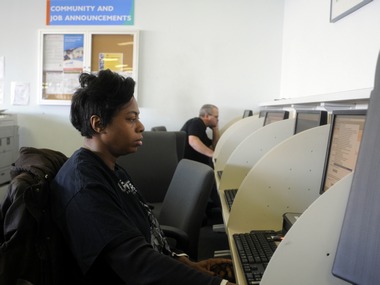The S&P 500 and Dow industrials hit intraday record highs on Friday and the benchmark S&P traded above 1,600 after US employment rose more than expected in April.
In addition, hiring was much stronger than previously thought in the prior two months, the Labor Department said, easing concerns that government spending cuts were dealing a blow to the economy.
[caption id=“attachment_750577” align=“alignleft” width=“380”] Nonfarm payrolls rose 165,000 last month and the jobless rate fell to 7.5 percent, the lowest level since December 2008. Reuters[/caption]
The Dow Jones industrial average rose 135.27 points or 0.91 percent, to 14,966.85, the S&P 500 gained 16.01 points or 1 percent, to 1,613.6 and the Nasdaq Composite added 34.62 points or 1.04 percent, to 3,375.25.
Nonfarm payrolls rose 165,000 last month and the jobless rate fell to 7.5 percent, the lowest level since December 2008, the Labor Department said on Friday.
Payrolls rose by 138,000 jobs in March, 50,000 more than previously reported, and job growth for February was revised up by 64,000 to 332,000, the largest gain since May 2010.
“Overall, a strong set of numbers which will reassure markets that the U.S. economy is not as weak as it may have seemed given some of the earlier data,” said Andrew Grantham, an economist at CIBC World Markets in Toronto.
Economists polled by Reuters had expected April payrolls to rise 145,000 and the unemployment rate to hold steady at 7.6 percent.
U.S. stocks rallied on the data, while government bonds fell hard. The dollar strengthened against the yen and pared losses against the euro.
The drop in the jobless rate reflected a gain in employment, rather than people leaving the workforce. The workforce actually expanded, while the labor force participation rate - the share of working-age Americans who either have a job or are looking for one - held steady at a 34-year low of 63.3 percent.
Still, some details of the report remained consistent with a slowdown in economic activity. Construction employment fell for the first time since May, while manufacturing payrolls were flat.
The average workweek pulled off a nine-month high, with a gauge of the overall work effort falling, but average hourly earnings rose four cents.
Reuters


)
)
)
)
)
)
)
)
)



